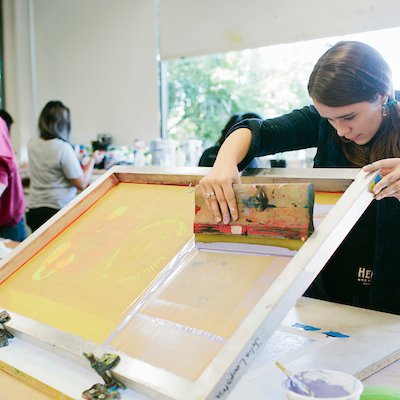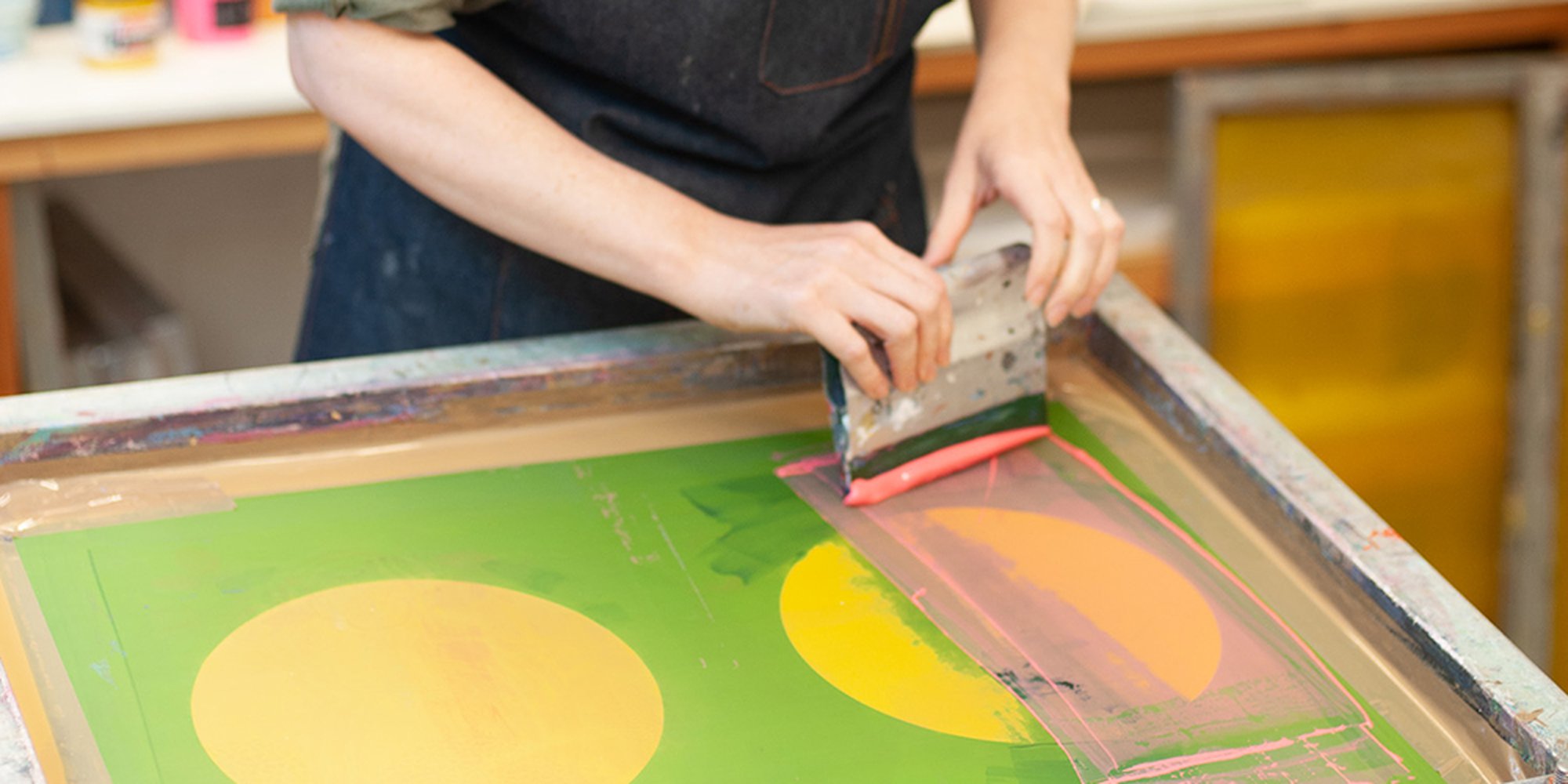Discover the Numerous Kinds Of Screen Printing Techniques for Your Following Task
Screen printing supplies a varied variety of techniques that can boost any innovative job. From traditional methods like serigraphy to modern-day technologies such as direct-to-garment printing, each technique has its special benefits. Specialized alternatives, consisting of metal and green inks, introduce also more possibilities. Recognizing these techniques can substantially affect the last outcome. Nevertheless, the obstacle depends on selecting one of the most appropriate technique for details demands and wanted results. What elements should one think about?

The Fundamentals of Screen Printing
Although screen printing may seem complex, it is basically a straightforward procedure that involves moving ink through a mesh screen onto numerous surfaces. The method begins with the creation of a stencil, which specifies the layout to be printed. This stencil is affixed to a mesh screen, typically made from polyester or nylon. As soon as the pattern is in place, ink is related to the screen and pressed through the mesh utilizing a squeegee, leading to the wanted pattern being published on the underlying material.
Screen printing can be executed on a vast array of substrates, including fabric, paper, and plastic, making it a versatile option for different tasks. The process allows for detailed designs and lively colors, making it popular in sectors such as style, advertising, and art. Recognizing these fundamentals equips individuals with the fundamental knowledge needed to explore even more innovative techniques in screen printing.
Standard Screen Printing Techniques
Standard screen printing strategies have actually been used for centuries, protecting the workmanship and creativity of this approach. This approach utilizes a mesh screen to move ink onto a substrate, such as material or paper, permitting long-lasting and vibrant styles. The procedure starts with producing a stencil, which obstructs certain locations of the screen to manage where the ink will be used.
One popular method is serigraphy, typically made use of for limited versions and artistic prints. One more is using water-based inks, which are eco-friendly and provide a soft feel on fabrics - 10:9 Design Screen Printing. Additionally, traditional approaches can include hands-on printing, where craftsmens use ink with a squeegee, guaranteeing accuracy and attention to information
These methods remain valued in the sector for their tactile quality and the distinct textures they generate, appealing to both designers and consumers who value the heritage of screen printing.
Digital Screen Printing Innovations
As the demand for faster manufacturing and modification in the printing sector has actually risen, digital screen printing developments have actually emerged as a game-changer. This innovation mixes traditional screen printing methods with electronic processes, permitting quick prototyping and detailed layouts that were previously tough to accomplish. One considerable innovation is the intro of direct-to-garment (DTG) printing, which promotes high-quality, full-color prints on different fabrics without the need for screens. In addition, advancements in ink formulas have resulted in environment-friendly choices that preserve vivid shades while lessening environmental influence. The usage of automated systems additionally streamlines production, minimizing labor prices and boosting precision. These innovations not only deal with little batch orders and customized designs yet likewise enable quicker turn-around times, making them ideal for organizations concentrated on conference consumer needs in a fast-paced market. Digital screen printing, subsequently, represents a vital development in the domain of printing methods.
Specialty Screen Printing Approaches
Checking out specialty screen printing methods exposes a diverse selection of techniques that press the boundaries of imagination and performance in the printing sector. Amongst these, glow-in-the-dark inks provide an unique visual effect, making designs come to life in low-light conditions. Metal inks, understood for their shimmering finish, add a touch of luxury to published products. Another innovative approach is discharge printing, which gets rid of color from the fabric rather than including ink, resulting in a soft, vintage feel. High-density printing creates an increased structure on the surface, enhancing responsive engagement. Additionally, water-based inks are obtaining popularity for their vibrant colors and reduced ecological influence. Each of these specialized techniques satisfies particular layout demands, enabling musicians and brands to develop standout products that reverberate with their audiences. By leveraging these techniques, businesses can click here raise their screen printing projects to new heights, making sure memorable impressions.
Eco-Friendly Screen Printing Options
Environment-friendly screen printing choices are acquiring traction as the industry shifts in the direction of sustainability. Lasting ink choices and making use of eco-friendly products are vital parts in reducing the ecological impact of the printing procedure. By taking on these methods, screen printers can add to an extra lasting future while preserving top notch results.
Lasting Ink Selections

Biodegradable Materials Use
As the screen printing sector evolves, the consolidation of biodegradable materials is ending up being increasingly essential for environmentally mindful techniques. Designers and suppliers are now exploring inks and substratums made from natural, sustainable sources that decay much more effectively than traditional counterparts. These naturally degradable choices minimize plastic waste and reduce ecological effect, aligning with the expanding demand for sustainable products.
Usual instances include water-based inks and organic cotton textiles, both of which lessen harmful chemicals and advertise eco-friendliness. Brand names that adopt these materials commonly enhance their market charm, drawing in consumers who focus on sustainability. As understanding of ecological problems proceeds to rise, the shift in the direction of naturally degradable products in screen printing is most likely to gain energy, promoting a greener industry criterion.
Picking the Right Method for Your Project
Just how can one determine one of the most appropriate screen printing method for a particular job? The choice rests on a number of aspects, consisting of the material to be published on, the complexity of the layout, and the preferred production volume - 10:9 Design Embroidery. Direct-to-garment printing is ideal for complex designs with countless colors, while typical screen printing succeeds for bigger runs of simpler graphics.
In addition, consideration of the end-use of the printed product is necessary. For outdoor applications, strategies that provide sturdiness and weather resistance, such as plastisol ink, may be preferred. Conversely, environmentally-conscious projects might take advantage of eco-friendly materials or water-based inks.
Ultimately, understanding the job's unique needs permits for an enlightened choice, guaranteeing both visual allure and functional durability. By assessing style complexity, product compatibility, and manufacturing scale, one can properly select one of the most ideal screen printing method to fulfill their project's objectives.
Frequently Asked Concerns
What Is the History of Screen Printing?
Screen printing stemmed in ancient China around 1000 AD, evolving via Japan and Europe. By the 20th century, it became preferred in commercial art and style, reinventing exactly how styles were created and distributed around the world.

Just how Do I Prepare Art Work for Screen Printing?
To prepare artwork for screen printing, one need to guarantee high resolution, make use of an appropriate shade mode, develop different layers for each color, and transform text to details, assuring compatibility with the printing procedure and preferred end result.
What Products Are Ideal for Screen Printing?
The ideal materials for screen printing include high-quality inks, sturdy screens, and appropriate substrates like cotton, polyester, or blends. Additionally, using ideal solution and squeegees can enhance the printing process and results.
Can I Evaluate Publish in your home?
Yes, screen printing in your home is possible. With the right products, setup, and methods, individuals can produce premium prints. Cautious factor to consider of workspace and equipment is essential for successful outcomes.
What Prevail Mistakes in Screen Printing?
Typical blunders in screen printing include incorrect direct exposure times, insufficient ink consistency, imbalance of displays, insufficient cleansing of materials, and ignoring to test prints. These mistakes can jeopardize the top quality and precision of the end product.
Screen printing may appear facility, it is basically an uncomplicated process that entails moving ink with a mesh screen onto various surfaces. As the demand for faster production and personalization in the printing sector has actually surged, digital screen printing technologies have arised as a game-changer. Discovering specialty screen printing approaches reveals a varied variety of methods that press the boundaries of creativity and capability in the printing sector. The ideal materials for screen printing include top quality inks, durable screens, and suitable substratums like cotton, polyester, or blends (10:9 Design Screen Printing). Common blunders in screen printing consist of improper direct exposure times, insufficient ink uniformity, imbalance of displays, inadequate cleaning of materials, and ignoring to evaluate prints